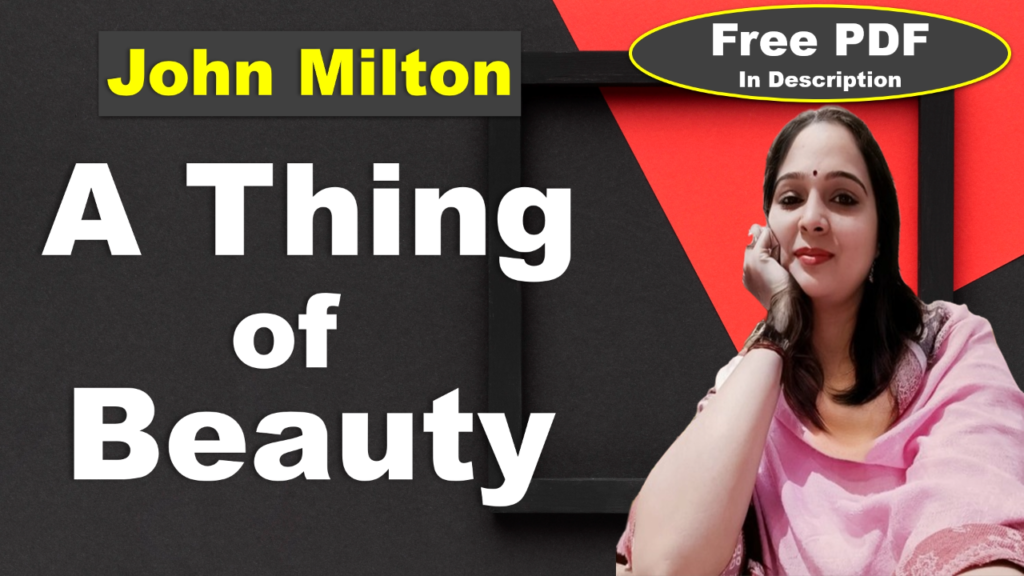
Essay Type Questions
Q. Write the critical appreciation of the poem “A Thing of Beauty?“
Introduction
“A Thing of Beauty” is a poem by John Keats, a prominent figure in the second generation of Romantic poets. This poem is an excerpt from his longer work, “Endymion”, and is renowned for its theme of the enduring power of beauty.
Theme and Subject Matter
The central theme of “A Thing of Beauty” is the enduring power of beauty. Keats suggests that beautiful things, whether they be in nature or in stories of the “mighty dead”, provide a source of endless delight. They have a soothing effect on our spirits, bringing us peace and comfort. Even in the midst of hardship, the beauty in the world provides a respite and serves as a source of joy and inspiration.
Imagery and Symbolism
Keats uses vivid imagery to bring the poem to life. He describes a variety of beautiful things in nature, including the sun, the moon, trees, daffodils, clear streams, and musk-rose blooms. These images collectively represent the beautiful bounty of the earth. The ‘mighty dead’ symbolize great historical figures, heroes, or individuals who have left a significant impact on the world. Their stories and deeds continue to inspire us, adding to the beauty in the world.
Rhyme and Meter
The poem is written in iambic pentameter and follows an AABB rhyme scheme. This rhythmic structure gives the poem a musical quality, enhancing its lyrical nature.
Tone and Mood
The tone of the poem is one of admiration and reverence for beauty. Keats expresses a deep appreciation for the beautiful things in the world and their ability to bring joy and comfort. The mood of the poem is reflective and contemplative, inviting the reader to consider the power of beauty in their own lives.
Conclusion: Impact and Legacy
“A Thing of Beauty” is a testament to Keats’s belief in the power of beauty. Despite the brevity of his life and career, Keats left a lasting impact on the world of poetry. His exploration of beauty and its effects on the human spirit continues to resonate with readers today. This poem, with its celebration of beauty and its power to bring joy amidst difficulties, is a shining example of Keats’s poetic genius and his contribution to Romantic literature.
Q. Discuss the poem “A Thing of Beauty” by John Keats in light of its poetic devices.
“A Thing of Beauty” by John Keats is a poem rich in poetic devices that enhance its depth and beauty. Here are some of the key poetic devices used in the poem:
Imagery
Keats uses vivid imagery to bring the poem to life. He describes a variety of beautiful things in nature, including the sun, the moon, trees, daffodils, clear streams, and musk-rose blooms. These images collectively represent the beautiful bounty of the earth.
Metaphor
Metaphor: The poem is filled with metaphors. For example, ‘bower quiet’ refers to a quiet shady part in the garden, ‘sweet dreams’ refer to happy dreams, ‘wreathing a flowery band’ refers to connecting to nature, ‘pall’ refers to a covering like a shroud, and ‘endless fountain of immortal drink’ refers to the deeds of great men and women that have made them a source of inspiration for people of all times.
Alliteration
Alliteration: Alliteration, the repetition of initial consonant sounds, is used in phrases like ‘shade of the boughs’ and ‘sweet dreams’. Other examples include ‘noble natures’, ‘cooling covert’, and ‘band to bind.
Rhyme
The poem is written in rhyming couplets, following an AABB rhyme scheme.
Assonance
Assonance: Assonance, the repetition of vowel sounds, is used in phrases like ‘deep-delved’ and ‘fostered’.
Symbolism
The poem is rich in symbolism. The ‘mighty dead’ symbolize great historical figures, heroes, or individuals who have left a significant impact on the world.





